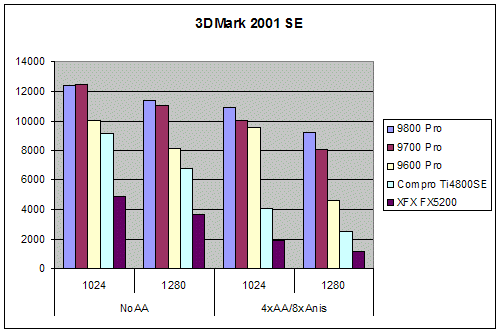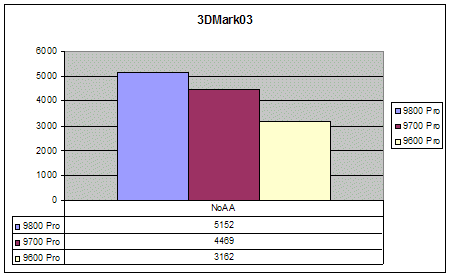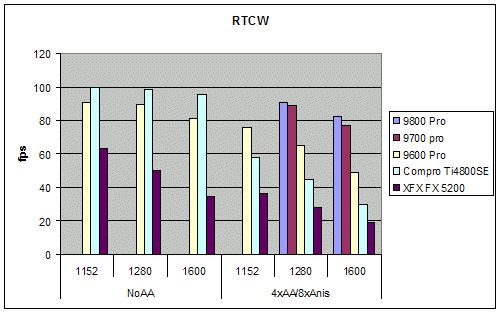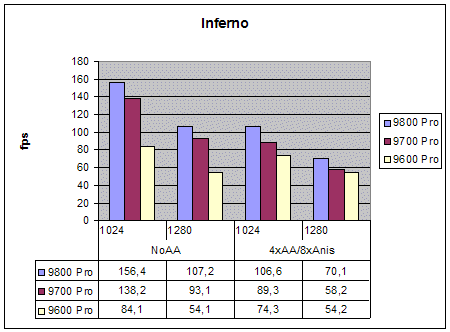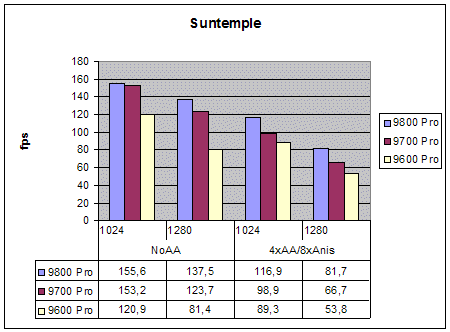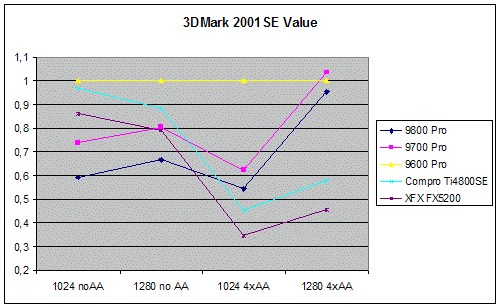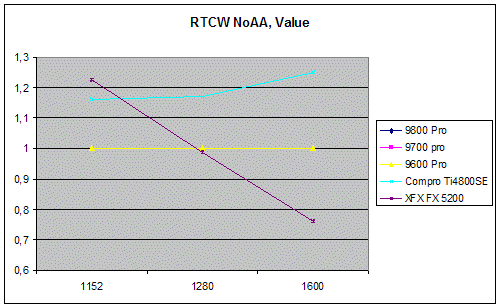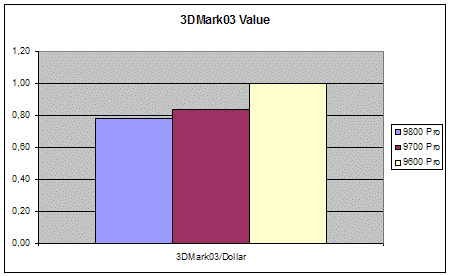Not content of owning the high-end ATI also want to own the mid-end. Today I am looking at the Radeon 9600 Pro to see what it offers.
Introduction
1 ½ month ago I had the opportunity to take a look at ATIs new flagship the Radeon 9800 (link to review). Today it is time to take a look at ATIs second new card the Radeon 9600 Pro. The one thing that makes this card a bit special is of course that it is built with .13u compared to the Radeon 9700 and Radeon 9800 that uses a 0.15u process.
Specifications & Feature
Neither the Radeon 9800 nor the Radeon 9600 are revolutionary products. Instead are they evolutionary products building on the foundation of the Radeon 9500/9700. The interesting specifications are:
DX9 and OpenGL2 support
The Radeon 9600 will be clocked at 325/400 and the Radeon 9600 pro at 400/600
Quadpixel pipeline (16 textures/pass, 128 bit floating point precision)
Dual Vertex Pipeline
Hyper Z III Performance optimizations
Smartshader 2.1
Smoothvision 2.1
To read more about Smartshader and Smoothvision 2.1 check out our article about the Radeon 9800,9600 and 9200.
Installation
As with most other ATI products the Radeon 9600 pro is quite short and uses just a regular fan. ATI has said that there might come out a fanless version of the 9600 pro in the future.
Installing the card was very straightforward (as usual). I had to use a special driver from ATI since the current Catalyst 3.2 doesnt support the 9600 pro but after I had installed it everything worked fine.
Benchmarks
Since I only had time to keep the card for 1 day before sending it to the next journalist I choose to use these benchmarks:
– 3Dmark2001SE
– RTCW
– UT2k3
I choose to compare the Radeon 9600 Pro to the Radeon 9700, the Radeon 9800, a Compro Ti4800SE and a XFX FX5200.The Radeon 9600 Pro and the Ti4800SE are in the same price range while the FX 5200 is cheaper and the Radeon 9700 and Radeon 9800 more expensive. Hopefully this comparison will give you an idea if the Radeon 9600 is worth the money or not.
The system where I tested all cards were:
– ShuttleX with nForce 2 mobo
– 512 MB DDR ram at 266 MHz
– Athlon XP2000+
– WinXP Pro with SP1
– Drivers: Catalyst 3.2 (Radeon 9700/9800), special Catalyst 3.2 for 9600 Pro, 43.45 for Ti4800SE and FX 5200.
– NVIDIA driver settings are set to use the best possible image quality. In the new drivers this is called Application.
3DMark2001
Our first benchmark is 3Dmark2001SE. I choose to benchmark it without AA and anisotropic filtering and with 4xAA and 8x Anisotropic filtering.
The Radeon 9600 Pro lags behind its big brothers but clearly beats the Compro Ti4800SE.
3DMark03
Lets see how the Radeon 9600 Pro compares to its bigger brothers in the new 3Dmark03 benchmark.
No surprises here.
RTCW
As our OpenGL benchmark I choose to use Return to Castle Wolfenstein v1.31. As always we choose to benchmark the game with sound turned on.
OpenGL has never been ATIs strength. This is quite evident when looking at the scores. The Ti4800SE beats the Radeon 9600 Pro without AA. In all resolutions the 4800SE is ahead at least 10 fps. However turn on AA and anisotropic filtering and the image changes. The Radeon 9600 Pro manages to draw ahead at least 20 fps over the Ti4800SE. However it does not manage to touch the Radeon 9700 or the Radeon 9800.
UT2K3
As our final benchmark we have UT2K3. While I intended to benchmark all the NVIDIA cards something didnt work correctly with the 43.45 drivers. I get tons of visual faults, flashing textures etc.. The scores also were all over the chart making no sense at all.
To benchmark UT2k3 I choose to use UT2k3bench. I choose to use the HardOCP benchmark which runs through a bunch of maps. Here are 2 of the maps that it uses. The rest of the maps yield the same relation between the cards.
Without AA the Radeon 9600 Pro clearly falls behind the Radeon 9700 and the Radeon 9800. Turn on AA it still is behind, just not as much.
Value
While benchmark scores are interesting there is another score that should be even more interesting the value of a card when considering the price. For this review I choose to look at the scores and then divide the scores with the price of each card. I also choose to normalize the scores so that the Radeon 9600 Pro always gets the score 1. If another card gets a score lower than 1 it means it has less value and if it gets a score >1 it has a better value than the Radeon 9600 Pro.
To get correct prices for each card I used our own price search (LINK) to find the best prices.
– Radeon 9800 Pro: $365
– Radeon 9700 Pro: $295
– Radeon 9600 Pro: $175 (from the suggested RRP)
– Ti4800SE: $165
– XFX FX5200: $99
3Dmark2001SE
Looking at 3Dmark2001SE scores the Radeon 9600 Pro clearly offers the best value at least up to 1280×1024 with 4XAA and 8x Anisotropic filtering. The card from NVIDIA that is matching the Radeon 9600 Pro in price has big problems when you look at the value.
RTCW
Once again ATIs weak OpenGL performance is affecting the value. Without any AA and Anisotropic filtering the Radeon 9600 cant touch the Ti4800SE in value. However turn on AA/Anisotropic filtering and the Radeon 9600 Pro leaves the competition in the dust.
3DMark03
Once again the Radeon 9600 Pro offers better value.
Conclusion
What is not to like about the Radeon 9600 Pro? Its a fast and future proof card. It might not reach the Radeon 9700/9800 levels but if you factor in the cost for each card the Radeon 9600 Pro clearly offers the best bang for buck. NVIDIA currently has no card that is close to offering the same value. The FX 5600 might perform a bit better than the Ti4800SE but I doubt it will be able to reach the 9600 Pro.
As it looks now ATI holds both the high-end and the mid-end with the Radeon 9800 and the Radeon 9600/Pro. NVIDIA does have some surprises up their sleeve but until NDAs expire and they come out and tell us all it really is hard to recommend a NVIDIA card over ATI.
For its value and performance I award the Radeon 9600 Pro the Bjorn 3D Seal of Approval and a score of 9 out of 10.
 Bjorn3D.com Bjorn3d.com – Satisfying Your Daily Tech Cravings Since 1996
Bjorn3D.com Bjorn3d.com – Satisfying Your Daily Tech Cravings Since 1996

